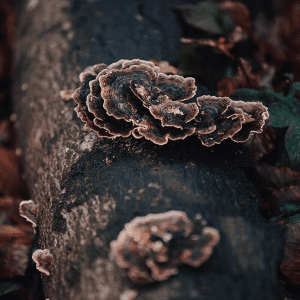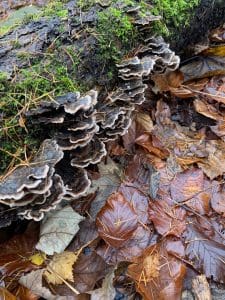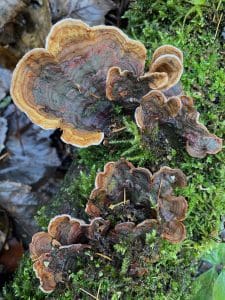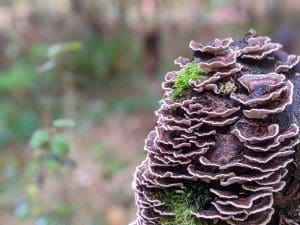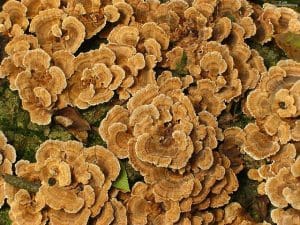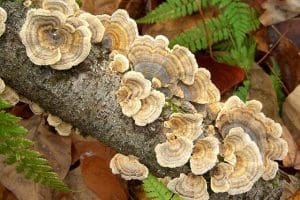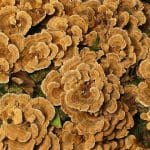Turkey Tails / All year round / Edible / Medicinal
Enter the realm of natural healing as we unveil the medicinal wonders of the Turkey Tails Mushroom (Trametes versicolor).
Join us on a journey where traditional medicine meets scientific exploration. With its colorful and intricate patterns resembling turkey feathers, the Turkey Tails Mushroom stands as a remarkable source of therapeutic potential.
Learn to identify its unique features, discover its preferred habitats, and delve into the medicinal benefits it offers. From its immune-boosting properties to its potential cancer-fighting compounds, this mushroom has been revered for its health-promoting qualities.
Whether you are seeking to support your well-being or embrace alternative healing practices, let the Turkey Tails Mushroom inspire you on your path to holistic wellness. Embrace the abundant gifts of nature as we celebrate the enchanting healing potential that lies within the Turkey Tails Mushroom. Get ready to embark on a journey of natural discovery as we explore the captivating medicinal possibilities offered by this remarkable fungus.
Common Names
Turkey Tails, Yun Zhi or Cloud Mushroom, Japanese Ladies Fan.
Botanical Name
Trametes Versicolor
Meaning of Botanical Name
Trametes meaning one who is thin and Versicolor meaning various colourings. The thin fungi with rings of various colourings.
Scientific Classification
Kingdom: Fungi, Division: Basidiomycota, Class: Agaricomycetes, Order: Polyporales, Family: Polyporaceae, Genus: Trametes, Species: T. Versicolor.
Known Hazards
None reported. Too tough to eat and best used to extract flavour. Eating whole fungi could lead to indigestion.
Could be confused with
Trametes ochacea of which the colourful rings are typically light ochre whereas T. Versicolor has rings of different shades of brown and smaller pores.
Trametes suavoelens, which is lighter and doesn’t grow in such large overlapping clusters.
Stereum hirsutum (False Turkey Tail) – this fungi has a yellow rim and a yellow underside with a smooth spore-bearing surface rather than pores.
Food of
Various fungi gnat larvae.
Range and Distribution
Throughout mainland Europe, UK, Northern, and mainland America, and all over Asia.
Habitat
Found typically in many layers growing from decaying hardwoods trunks and stumps (occasionally on conifers).
Physical Characteristics of Turkey Tails
Very thin fungi 1-3mm thick, growing from wood in a semicircular fashion. The cap, 5-8cm, is of leathery texture and contains concentric zones or rings of different colours ranging from golden rust to dark brown and can often appear to have green algae growing around its edges, although the edges are often more of a cream colour.
The underside and pore surface ranges from bold white to light brown, the pore themselves are round, 2-5 pores per millimetre. It is often found on dead hard woods and found growing in rows and large tiered clusters.
Folklore, tall tales, and not so folklore
According to Silvercord, as reported by Robert Rogers in his Fungal Pharmacy, the essence of this fungus “Is for the eternal worrier, for those who need to ground their energies into the physical world and for those who work with nature.”
Herbal
These fungi has a huge remit of medicinal and herbal uses, traditionally it has been used to increase circulation, for skin complaints, to help with arthritis, rheumatism, and gout. More recently this fungus has come under heavy research mainly in China and Japan for its immune-stimulating polysaccharides, specifically for their use in the treatment of cancer. Through these tests the fungi has shown some truly amazing results, enhancing the effects of radiation and chemotherapy, prolonging the activity of antibiotics and much, much more.
Miscellaneous
If you’re out in the woods you can use this fungus as a substitute for chewing gum – not for the taste specifically but more if you like the distraction of continually chewing something. After 30 minutes of chewing, you can set aside until you accumulate enough to make paper with.
Parts for Dyeing
You can extract and use a weak brown or greyish yellow color from this fungi – it can be used for dying without a mordant and can be laked with chalk, although the greyish-yellow comes through less dramatically this way.
Suitability for Paper Making
Miriam Rice rates this fungus as the top one to use in papermaking, we agree it works well but the resulting paper can be dark and the fungus can be a pain to clean prior to use. Using it in conjunction with another fiber, such as nettle, increases the potential of this fungus for paper use dramatically.
Tips and Observations
Turkey tails can persist and remain for a long time on the log, make sure they’re fresh and not a remnant from the previous season (for both papermaking and food use) – a good way to tell whether they are fresh is that the edge and underside are still white, pale and spongy.
The last word goes to…
“So let me get this straight, you wrote the dinner menu on paper made from the very same fungi that flavoured the soup as described on the menu! That’s bonkers fun!”



